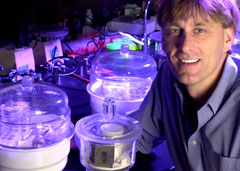|
Release date: Nov. 10, 2004 Molecular Self-Assembly Research Leads to Alzheimer's Discovery
Lynn, Asa Griggs Candler Professor of Chemistry and Biology, works in the areas of biomolecular chemistry, molecular evolution and chemical biology. His research in biological chemistry focuses on the spontaneous self-assembly of biological structures, including protein folding, vessicle formation and the organogenesis of multicellular organisms, as well as the basis of the energies that control self-assembly. As physical and materials technology converge with the world of biology, and genomic sequencing provides more information, scientists are starting to learn "the most fundamental structural and functional secrets of living organisms," says Lynn, describing his research. "Dominant among them is the realization that the complex structures of biology seem remarkably, almost magically, to self-assemble." Recently Lynn and his collaborators have discovered a new method to manipulate the self-assembly and formation of amyloid fibrils, a major component of brain plaques associated with Alzheimer's disease, that is providing insights on how the fibrils form at the molecular level. They have been able to manipulate amyloid fibrils, which are ribbon-like peptide chains of amino acids (the building blocks of proteins), so that instead of forming the typical tendrils that twist and tangle into plaques as they do in the brains of Alzheimer's patients, the amyloid proteins self-assembled into tubes up to 15 nanometers wide, or 15 billioneths of a meter. The creation of the nanotubes opens new avenues to examine the structure of amyloids, while also serving as minute scaffolds to build nanotechnological devices for numerous uses in research, industry and medicine. The findings were recently published in the Journal of the American Chemical Society. "We took what we know about amyloid fibril self-assembly, and used that information to construct novel, self-assembling nanotubes. The creation of these new structures will in turn teach us more about the physical properties of amyloids and the pathways to their formation, which puts us in a better position to understand why they are so damaging and cause disease," says Lynn. The discovery has other benefits by demonstrating the potential of "synthetic biology," or showing how it is possible to use elements that nature goes to great lengths to avoid, and convert them in to new functional materials, Lynn says. "Nature goes to extreme measures to keep these amyloids from forming, but nature still hasn't figured out a way on its own to totally control the formation of them," he says. "What we have uncovered is a way to control and manipulate the amyloid in a way that nature can't, so that it acts differently and takes on a new form as a self-assembling nanotube that has many applications for nanotechnology." Lynn is the founder of Emory's Center for Fundamental and Applied Molecular Evolution (FAME), a jointly sponsored initiative between Emory and the Georgia Institute of Technology. Established in November 2002, its primary scientific goals are the studies of evolutionary principles and their application to the synthesis of novel molecules and materials in the laboratory. The research center applies the principles of molecular evolution to solve problems ranging from the decaffeination of coffee to the environmentally friendly synthesis of antibiotics. Highly interdisciplinary, the group is composed of scientists drawn from a broad array of backgrounds, chemists, biologists, biochemists, and chemical engineers, together focusing on fundamental questions at the critical interfaces between chemistry, biology and physics. ###
|
|
||||||||||||
copyright 2001
For more information contact:

